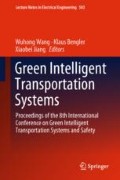Abstract
There is a tendency that drivers do not usually use optimal strategy in imminent intersection conflicts. Drivers usually swerve to the same direction as the obstacle, which sometimes results in accidents. In this paper, driving simulation experiments were conducted focusing on drivers’ reaction—especially, the swerving behavior—in critical intersection situations. The influences of incursion side and obstacle velocity were examined during the experiments. The results proved the existence of drivers’ same-direction-pattern (SDP) swerving maneuver, as the proportion of same-direction-swerving (SDS) was tremendously higher than what it should be in both left- and right incursion situations. The work serves as a foundation for further research on accident causation and Advanced Driver Assistant Systems (ADAS) development.
Access this chapter
Tax calculation will be finalised at checkout
Purchases are for personal use only
References
Figueiredo L, Jesus I, Machado JAT, Ferreira JR, Martins (2001) Towards the development of intelligent transportation systems. In: Intelligent transportation systems proceedings, pp 1206–1211
Adams LD (1994) Review of the literature on obstacle avoidance maneuvers: Braking versus steering (Tech. Rep. No. UMTRI-94-19),” Ann Arbor: University of Michigan, Transportation Research Institute
Edwards ML, Malone S (1982) Driver crash avoidance behavior. Unpublished manuscript. National Highway Traffic Safety Administration. NHTSA Driver Performance Handbook
Limpert R, Garnero FE (1974) The accident avoidance potential of the motor vehicle: accident data, vehicle handling and safety standards. In: Proceedings of the third international congress on automotive safety, vol 11. Washington D.C., GPO, 61p
Malaterre B, Ferrandez F, Fleury D, Lechner D (1988) Decision making in emergency situations. Ergonomics 31(4), 643–655
Ferrandez F, Fleury D, Lepesant D (1984) Analysetypologique des manoeuvresd’urgence. Rapport ONSER
Hatterick GR, Bathurst JR (1976) Accident avoidance skill training and performance testing (Final Report No. DOT/HS 801852). Falls Church, VA: URSIMatrix Company
Hancock P, Ridder SD (2003) Behavioural accident avoidance science: understanding response in collision incipient conditions. Ergonomics 46(12):1111–1135
Sieber M, Färber B (2016) Driver perception and reaction in collision avoidance: implications for ADAS development and testing. In: 2016 IEEE intelligent vehicles symposium (IV) Gothenburg, Sweden, 19–22 June 2016
Xuedong Y, Rami H, Essam R (2008) Analyses of factors of crash avoidance maneuvers using the general estimates system. Traffic Inj Prev 9:2
Kramer F, Israel M (2014) “VirtuellerGreifreflex” — einKonfliktpotenzial und die Möglichkeiten der Kompensation in PersonenkraftwagenmithilfemodernerAssistenzsysteme [“Virtual Grasp Reflex” — a potential for conflict and the possibilities of compensation in passenger cars with the aid of modern assistance systems]. VKU Verkehrsunfall Fahrzeugtechnik 52(11):390–399
Weber S (2013) GibtesStandardreaktionenimUnfallgeschehen? Internal presentation for AUDI AG, Ingolstadt, Germany, 25 Nov 2013
Weber S, Färber B (2015) Driver reactions in critical crossing situations. In: 2015 IEEE 18th international conference on intelligent transportation systems. Las Palmas
Weber S, Blum K, Ernstberger A, Färber B (2015) Standard reactions—driver reactions in critical driving situations. In: 6th international conference on applied human factors and ergonomics and the affiliated conferences, Las Vegas
Lechner D, Malaterre G (1991) Emergency maneuver experimentation using a driving simulator. In: Presented at Autotechnologies, 5th Conference and Exposition, Monte Carlo, Monaco. Report No. SAE 910016
Hankey JM, McGehee DV, Dingus TA, Mazzae EN, Garrott WR (1996) Initial driver avoidance behavior and reaction time to an unalerted intersection incursion. In: Proceedings of the Human Factors and Ergonomics Society 40th annual meeting. Human Factors and Ergonomics Society, Santa Monica, CA, pp 896–899
McGehee DV, Mazzae EN, Baldwin GHS, Grant P, Simmons CJ, Hankey J, Forkenbrock G (1999) Examination of drivers’ collision avoidance behavior using conventional and antilock brake systems on the Iowa driving simulator (Final rep.). University of Iowa, Iowa City
Acknowledgements
The work is supported by Individual Research Founding of State Key Laboratory of Automotive Safety & Energy, Tsinghua University (ZZ2016-032).
Author information
Authors and Affiliations
Corresponding author
Editor information
Editors and Affiliations
Rights and permissions
Copyright information
© 2019 Springer Nature Singapore Pte Ltd.
About this paper
Cite this paper
Hu, M., Zhang, W., Li, P., Zheng, Z., Li, Y. (2019). Drivers’ Collision Avoidance Pattern Before Imminent Intersection Accidents. In: Wang, W., Bengler, K., Jiang, X. (eds) Green Intelligent Transportation Systems. GITSS 2017. Lecture Notes in Electrical Engineering, vol 503. Springer, Singapore. https://doi.org/10.1007/978-981-13-0302-9_70
Download citation
DOI: https://doi.org/10.1007/978-981-13-0302-9_70
Published:
Publisher Name: Springer, Singapore
Print ISBN: 978-981-13-0301-2
Online ISBN: 978-981-13-0302-9
eBook Packages: EngineeringEngineering (R0)

